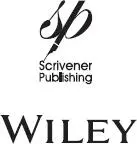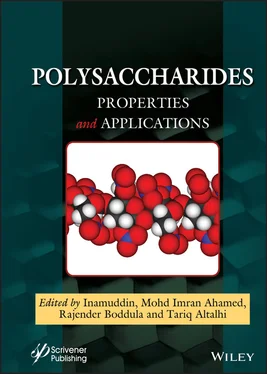Inamuddin, Mohd Imran Ahamed
Rajender Boddula
and
Tariq Altalhi

This edition first published 2021 by John Wiley & Sons, Inc., 111 River Street, Hoboken, NJ 07030, USA and Scrivener Publishing LLC, 100 Cummings Center, Suite 541J, Beverly, MA 01915, USA © 2021 Scrivener Publishing LLC For more information about Scrivener publications please visit www.scrivenerpublishing.com.
All rights reserved. No part of this publication may be reproduced, stored in a retrieval system, or transmitted, in any form or by any means, electronic, mechanical, photocopying, recording, or otherwise, except as permitted by law. Advice on how to obtain permission to reuse material from this title is available at http://www.wiley.com/go/permissions.
Wiley Global Headquarters
111 River Street, Hoboken, NJ 07030, USA
For details of our global editorial offices, customer services, and more information about Wiley products visit us at www. wiley.com.
Limit of Liability/Disclaimer of Warranty
While the publisher and authors have used their best efforts in preparing this work, they make no representations or warran-ties with respect to the accuracy or completeness of the contents of this work and specifically disclaim all warranties, including without limitation any implied warranties of merchant-ability or fitness for a particular purpose. No warranty may be created or extended by sales representatives, written sales materials, or promotional statements for this work. The fact that an orga-nization, website, or product is referred to in this work as a citation and/or potential source of further information does not mean that the publisher and authors endorse the information or services the organization, website, or product may provide or recommendations it may make. This work is sold with the understanding that the publisher is not engaged in rendering pro-fessional services. The advice and strategies contained herein may not be suitable for your situation. You should consult with a specialist where appropriate. Neither the publisher nor authors shall be liable for any loss of profit or any other commercial damages, including but not limited to special, incidental, consequential, or other damages. Further, readers should be aware that websites listed in this work may have changed or disappeared between when this work was written and when it is read.
Library of Congress Cataloging-in-Publication Data
ISBN 978-1-119-71138-4
Cover image: Pixabay.Com Cover design by Russell Richardson
Set in size of 11pt and Minion Pro by Manila Typesetting Company, Makati, Philippines
Printed in the USA
10 9 8 7 6 5 4 3 2 1
Polysaccharides are versatile and abundant biopolymers derived from natural resources which have emerged as a sustainable and eco-friendly alternative to conventional polymers or traditional plastics. Due to their unique properties, such as good stability, safety, low tox-icity, low cost, hydrophilicity, supramolecular structure, gelation ability, biodegradability and flexibility, polysaccharides have been the subject of multidisciplinary research in the fields of chemistry, physics, food science, materials science and biology. This book presents the entire spectrum of polysaccharide-related topics—from basic concepts to commercial market applications. The chapters cover various sources, classifications, properties, charac-terizations, processing methods, rheologies and fabrications of polysaccharide-based mate-rials and their composites and gels. Also covered are the applications of polysaccharides in cosmetics, food science, drug delivery, biomedicine, biofuel production, the applications, packaging, chromatography and environmental remediation. In addition to incorporating industrial applications and filling in the gap between exploratory works in the laboratory and viable applications in related ventures, this book also reviews the fabrication of inor-ganic and carbon nanomaterials from polysaccharides.
Since recent developments in the field are highlighted and real examples of polysaccha-rides in practice are provided along with key references, this book is an invaluable resource for both industry professionals and entrepreneurs in the field. As can be seen from the range of topics covered in the chapters summarized below, the book is also essential read-ing for industrialists, scientists, university professors, lecturers, researchers, doctoral and master students working in the fields of polymer science and technology, material science, chemistry, biology, and medicine.
Chapter 1describes the composition of aloe vera mucilaginous gel, its major polysac-charides and their applications. The processes for obtaining the mucilaginous gel and its polysaccharide fractions, as well as the analytical methods applied for the quantification of total carbohydrates, oligosaccharides, acemannan, and free sugars are addressed.
Chapter 2provides details about the cell wall of plant, algae, fungi and bacteria as the best reservoir of polysaccharides. Different types of polysaccharides like cellulose, hemi-cellulose and pectin representing the most prominent component of the cell wall are dis-cussed. Furthermore, various applications of polysaccharides in living organisms ranging from their structure to biological signaling are described. Additionally, various commercial applications of polysaccharides in pharmaceutical, paper, cosmetic and food industries are highlighted.
Chapter 3primarily concentrates on the major marine polysaccharides, which in light of their diversity and complexity are addressed along with their underlying fundamental principles.
Chapter 4provides details on the seaweed polysaccharides—agar, alginate, carrageenan, fucoidan, laminarin and ulvan—which have profound applications in food, pharmaceutical and many other chemical fields. Chemical structures and properties of polysaccharides are also discussed. Additionally, procedures for seaweed polysaccharides’ extraction and appli-cation areas are presented in detail.
Chapter 5deals with all aspects of polysaccharide. It also discusses variable methods to alter agar characteristics according to the type of work, the heterogeneity, synergies, physico-chemical and chemical properties along with mass spectroscopic, NMR, and XRD analyses.
Chapter 6addresses the major properties and classifications of natural polysaccharides and deals with the applications of these green and sustainable resources in many different fields and industries, including biomedicine, food, cosmetics, textiles, wastewater treat-ment, and energy production.
Chapter 7discusses the properties of chitosan enhanced by the addition of various functional groups. The understanding of chitosan derivatives for various biomedical, envi-ronmental, and food applications which can help in the development of other novel appli-cations are also discussed.
Chapter 8discusses six different types of green seaweed containing a large amount of high-value polysaccharides (sulfated galactans, ulvan, sulfated arabinans, sulfated arab-inogalactans and mannans) in their biomass composition. Additionally, these extracted natural carbohydrates have important physiological and biological roles such as having anti-inflammatory, immunomodulation, antioxidant, anticoagulant, and anti-tumor effects in the human body.
Chapter 9reveals the specific functional properties and nutritional value in the food applications of salep powder produced from tubers of the Orchidaceae family, an important glucomannan source. The production, cultivation, purification, deacetylation and depo-lymerization of glucomannan show new functional properties, which are summarized in detail.
Читать дальше

